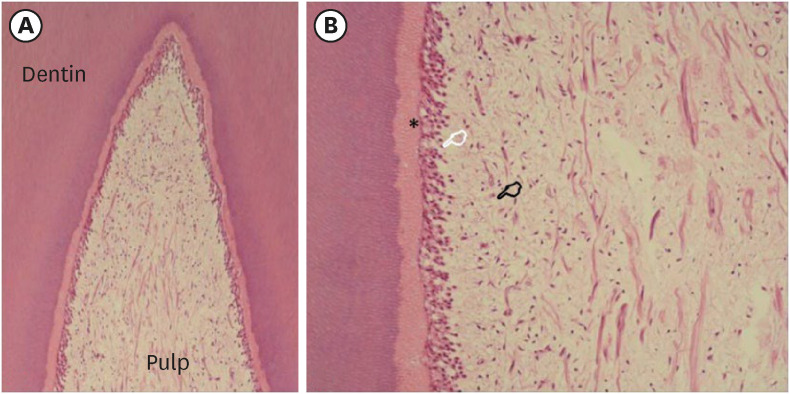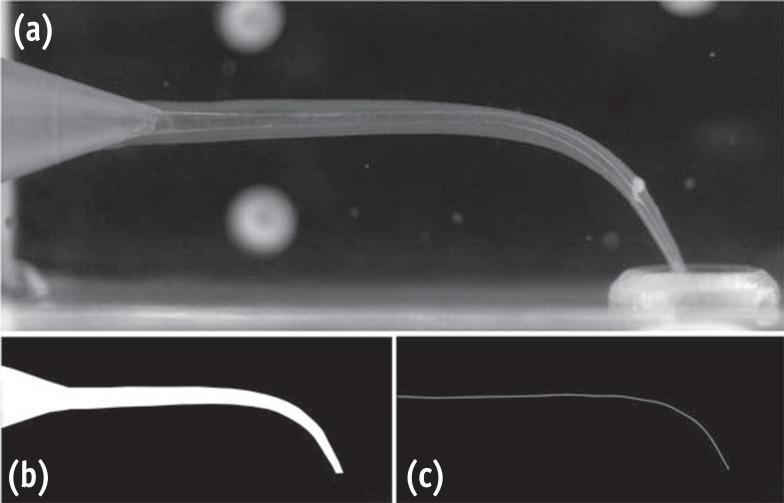-
Effect of medium or high concentrations of in-office dental bleaching gel on the human pulp response in the mandibular incisors
-
Douglas Augusto Roderjan, Rodrigo Stanislawczuk, Diana Gabriela Soares, Carlos Alberto de Souza Costa, Michael Willian Favoreto, Alessandra Reis, Alessandro D. Loguercio
-
Restor Dent Endod 2023;48(2):e12. Published online March 8, 2023
-
DOI: https://doi.org/10.5395/rde.2023.48.e12
-
-
 Abstract Abstract
 PDF PDF PubReader PubReader ePub ePub
- Objectives
The present study evaluated the pulp response of human mandibular incisors subjected to in-office dental bleaching using gels with medium or high concentrations of hydrogen peroxide (HP). Materials and MethodsThe following groups were compared: 35% HP (HP35; n = 5) or 20% HP (HP20; n = 4). In the control group (CONT; n = 2), no dental bleaching was performed. The color change (CC) was registered at baseline and after 2 days using the Vita Classical shade guide. Tooth sensitivity (TS) was also recorded for 2 days post-bleaching. The teeth were extracted 2 days after the clinical procedure and subjected to histological analysis. The CC and overall scores for histological evaluation were evaluated by the Kruskal-Wallis and Mann-Whitney tests. The percentage of patients with TS was evaluated by the Fisher exact test (α = 0.05). ResultsThe CC and TS of the HP35 group were significantly higher than those of the CONT group (p < 0.05) and the HP20 group showed an intermediate response, without significant differences from either the HP35 or CONT group (p > 0.05). In both experimental groups, the coronal pulp tissue exhibited partial necrosis associated with tertiary dentin deposition. Overall, the subjacent pulp tissue exhibited a mild inflammatory response. ConclusionsIn-office bleaching therapies using bleaching gels with 20% or 35% HP caused similar pulp damage to the mandibular incisors, characterized by partial necrosis, tertiary dentin deposition, and mild inflammation.
-
Citations
Citations to this article as recorded by  - Can pigments of different natures interfere with the cytotoxicity from in-office bleaching?
Rafael Antonio de Oliveira Ribeiro, Beatriz Voss Martins, Marlon Ferreira Dias, Victória Peruchi, Caroline Anselmi, Igor Paulino Mendes Soares, Josimeri Hebling, Vanessa Cavalli, Carlos Alberto de Souza Costa
Odontology.2025; 113(4): 1447. CrossRef - Does Patient Age Impact In-Office Tooth Bleaching Outcomes? A Parallel Clinical Trial
JL Martins, IS Araújo, JF Rabelo, CJ Soares, AL Faria-e-Silva, AD Loguercio, PCFS Filho, HL Carlo, GR da Silva
Operative Dentistry.2025; 50(3): 251. CrossRef - The pH of Bleaching Gels on the Structural and Biological Response of Dental Tissues: A Scoping Review
Jamile Menezes de Souza, Maria Olimpia Paz Alvarenga, Ana Luisa Cassiano Alves Bezerra, Gabriela Queiroz de Melo Monteiro
Journal of Esthetic and Restorative Dentistry.2025; 37(10): 2193. CrossRef - DENTA: A Dual Enzymatic Nanoagent for Self‐Activating Tooth Whitening and Biofilm Disruption
Junseok Kim, Dai‐Hwan Kim, Priyannth R. Sundharbaabu, Chae Yeon Lee, Jina Bae, Jiyu Hyun, Young‐Ju Jang, Haeni Kim, Min‐Ho Hong, Juewen Liu, Tobias Fey, Suk Ho Bhang, Jun Hyuk Heo, Jung Heon Lee
Advanced Functional Materials.2025;[Epub] CrossRef - Efficacy of 35 % self-mixed hydrogen peroxide In-office bleaching with reduced application time: A single-blind randomized controlled trial
Gabrielle Gomes Centenaro, Deisy Cristina Ferreira Cordeiro, Maria Alice de Matos Rodrigues, Mariah Maluf Lenhani, Roberta Micheten Dias, Cristina Gómez Polo, Alessandra Reis, Alessandro D. Loguercio
Journal of Dentistry.2025; 163: 106178. CrossRef - Combined catalytic strategies applied to in-office tooth bleaching: whitening efficacy, cytotoxicity, and gene expression of human dental pulp cells in a 3D culture model
Rafael Antonio de Oliveira Ribeiro, Victória Peruchi, Igor Paulino Mendes Soares, Filipe Koon Wu Mon, Diana Gabriela Soares, Josimeri Hebling, Carlos Alberto de Souza Costa
Clinical Oral Investigations.2024;[Epub] CrossRef - Low and high hydrogen peroxide concentrations of in-office dental bleaching associated with violet light: an in vitro study
Isabela Souza Vardasca, Michael Willian Favoreto, Mylena de Araujo Regis, Taynara de Souza Carneiro, Emanuel Adriano Hul, Christiane Philippini Ferreira Borges, Alessandra Reis, Alessandro D. Loguercio, Carlos Francci
Clinical Oral Investigations.2024;[Epub] CrossRef - Evaluation of hydrogen peroxide permeability, color change, and physical–chemical properties on the in‐office dental bleaching with different mixing tip
Michael Willian Favoreto, Sibelli Olivieri Parreiras, Michel Wendlinger, Taynara De Souza Carneiro, Mariah Ignez Lenhani, Christiane Phillipini Ferreira Borges, Alessandra Reis, Alessandro D. Loguercio
Journal of Esthetic and Restorative Dentistry.2024; 36(3): 460. CrossRef - Catalysis-based approaches with biopolymers and violet LED to improve in-office dental bleaching
Rafael Antonio de Oliveira Ribeiro, Beatriz Voss Martins, Marlon Ferreira Dias, Victória Peruchi, Igor Paulino Mendes Soares, Caroline Anselmi, Josimeri Hebling, Carlos Alberto de Souza Costa
Lasers in Medical Science.2024;[Epub] CrossRef - Feasibility and Safety of Adopting a New Approach in Delivering a 450 nm Blue Laser with a Flattop Beam Profile in Vital Tooth Whitening. A Clinical Case Series with an 8-Month Follow-Up
Reem Hanna, Ioana Cristina Miron, Stefano Benedicenti
Journal of Clinical Medicine.2024; 13(2): 491. CrossRef - Hydrogen Peroxide in the Pulp Chamber and Color Change in Maxillary Anterior Teeth After In-Office Bleaching
Alexandra Mena-Serrano, Sandra Sanchez, María G. Granda-Albuja, Michael Willian Favoreto, Taynara de Souza Carneiro, Deisy Cristina Ferreira Cordeiro, Alessandro D. Loguercio, Alessandra Reis
Brazilian Dental Journal.2024;[Epub] CrossRef - Influence of coating dental enamel with a TiF4-loaded polymeric primer on the adverse effects caused by a bleaching gel with 35% H2O2
Victória Peruchi, Rafael Antonio de Oliveira Ribeiro, Igor Paulino Mendes Soares, Lídia de Oliveira Fernandes, Juliana Rios de Oliveira, Maria Luiza Barucci Araújo Pires, Josimeri Hebling, Diana Gabriela Soares, Carlos Alberto de Souza Costa
Journal of the Mechanical Behavior of Biomedical Materials.2024; 153: 106497. CrossRef
-
3,107
View
-
83
Download
-
11
Web of Science
-
12
Crossref
-
Antioxidant therapy enhances pulpal healing in bleached teeth
-
Adriano Fonseca Lima, Marcelo Rocha Marques, Diana Gabriela Soares, Josimeri Hebling, Giselle Maria Marchi, Carlos Alberto de Souza Costa
-
Restor Dent Endod 2016;41(1):44-54. Published online February 1, 2016
-
DOI: https://doi.org/10.5395/rde.2016.41.1.44
-
-
 Abstract Abstract
 PDF PDF PubReader PubReader ePub ePub
- Objectives
The purpose of this study was to evaluate the histopathological effects of an antioxidant therapy on the pulp tissue of rat teeth exposed to a bleaching gel with 35% hydrogen peroxide. Materials and MethodsForty rats were subjected to oral ingestion by gavage of distilled water (DW) or ascorbic acid (AA) 90 min before the bleaching therapy. For the bleaching treatment, the agent was applied twice for 5 min each to buccal surfaces of the first right mandibular molars. Then, the animals were sacrificed at 6 hr, 24 hr, 3 day, or 7 day post-bleaching, and the teeth were processed for microscopic evaluation of the pulp tissue. ResultsAt 6 hr, the pulp tissue showed moderate inflammatory reactions in all teeth of both groups. In the DW and AA groups, 100% and 80% of teeth exhibited pulp tissue with significant necrosis and intense tissue disorganization, respectively. At 24 hr, the AA-treated group demonstrated a greater regenerative capability than the DW group, with less intense inflammatory reaction and new odontoblast layer formation in 60% of the teeth. For up to the 7 day period, the areas of pulpal necrosis were replaced by viable connective tissue, and the dentin was underlined by differentiated odontoblast-like cells in most teeth of both groups. ConclusionsA slight reduction in initial pulpal damage during post-bleaching was promoted by AA therapy. However, the pulp tissue of AA-treated animals featured faster regenerative potential over time.
-
Citations
Citations to this article as recorded by  - Influence of dental bleaching on the pulp tissue: A systematic review of in vivo studies
Mariana Viana Donato, Alexandre Henrique dos Reis‐Prado, Lucas Guimarães Abreu, Lara Cancella de Arantes, Juliana Goto, Hebertt Gonzaga dos Santos Chaves, Luciano Tavares Angelo Cintra, André Luiz Fraga Briso, Isabella Faria da Cunha Peixoto, Francine Ben
International Endodontic Journal.2024; 57(6): 630. CrossRef - ANALYSIS OF THE INFLUENCE OF THE TEETH WHITENING PROCEDURE ON THE GUM AND CYTOKINE PROFILE OF ORAL FLUID (LITERATURE REVIEW)
S. S. Bozhik, N. V. Hasyuk, V. B. Radchuk
Bulletin of Problems Biology and Medicine.2024; 1(3): 17. CrossRef - Assessing the Viability of Laser-Activated Dental Bleaching Compared to Conventional In-Office Bleaching Methods: A Systematic Review of Clinical and In Vitro Studies
Eugenia Anagnostaki, Valina Mylona, Steven Parker, Mark Cronshaw, Martin Grootveld
Applied Sciences.2023; 13(22): 12459. CrossRef - Effects of the application of sodium ascorbate after in-office bleaching on the penetration of hydrogen peroxide, color change, and microtensile bond strength
Alexandra Mena-Serrano, María G. Granda-Albuja, Jenny Naranjo, Eliana Aldás Fierro, Michael Willian Favoreto, Alessandro D. Loguercio, Alessandra Reis
Brazilian Dental Journal.2023; 34(5): 87. CrossRef - Can different agents reduce the damage caused by bleaching gel to pulp tissue? A systematic review of basic research
Letícia Aparecida Silva Batista, Alexandre Henrique dos Reis-Prado, Hebertt Gonzaga dos Santos Chaves, Lara Cancella de Arantes, Luís Fernando Santos Alves Morgan, Carolina Bosso André, Thaís Yumi Suzuki, Francine Benetti
Restorative Dentistry & Endodontics.2023;[Epub] CrossRef - Design of a thermosensitive ibuprofen-loaded nanogel as smart material applied as anti-inflammatory in tooth bleaching: An in vivo study
Samara K.S.C.F. Moura, Milena L.V. dos Santos, Lucas A. do Nascimento, Mariana F.A. da Silva, Glória M. de França, Lucas M. da Costa, Aldo C. Medeiros, Raimundo F. Araújo-Júnior, Aurigena A. de Araújo, Cláudia N. Oliveira, André L. Dorini, Rejane A. de Ca
Journal of Drug Delivery Science and Technology.2022; 68: 103123. CrossRef - Effect of bleaching gel volume on color change and postoperative sensitivity: a randomized clinical study
Lara Maria Bueno Esteves, Paulo Henrique dos Santos, Ticiane Cestari Fagundes, Marjorie de Oliveira Gallinari, Giulia Bessa de Mello Antonaccio, Luciano Tavares Ângelo Cintra, André Luiz Fraga Briso
Clinical Oral Investigations.2022; 26(3): 2527. CrossRef - Human Dental Pulp Stem Cells Exhibit Different Biological Behaviours in Response to Commercial Bleaching Products
Carmen Llena, Mar Collado-González, Christopher Joseph Tomás-Catalá, David García-Bernal, Ricardo Elías Oñate-Sánchez, Francisco Javier Rodríguez-Lozano, Leopoldo Forner
Materials.2018; 11(7): 1098. CrossRef - Concentration‐dependent effect of bleaching agents on the immunolabelling of interleukin‐6, interleukin‐17 and CD5‐positive cells in the dental pulp
F. Benetti, J. E. Gomes‐Filho, L. L. Ferreira, G. Sivieri‐Araújo, E. Ervolino, A. L. F. Briso, L. T. A. Cintra
International Endodontic Journal.2018; 51(7): 789. CrossRef
-
1,217
View
-
5
Download
-
9
Crossref
|








